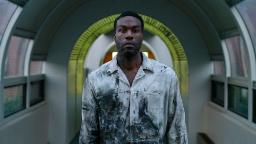Producer Jordan Peele mastered the central part of that combination in “Get Out,” and collaborating on the script with Win Rosenfeld and director Nia DaCosta (already tapped to helm Marvel’s upcoming “The Marvels”), does so less successfully here. It’s worth noting that the movie was originally scheduled for a June 2020 release before pandemic-related delays, and its themes certainly would have resonated just as loudly amid the summer of widespread Black Lives Matter protests.
For those who might need a “Candyman” refresher course, the 1992 movie starred Tony Todd in the title role, as a ghostly figure haunting the Cabrini-Green housing projects in Chicago. The movie begins in the same general location, which has since been gentrified, with artist Anthony McCoy (Yahya Abdul-Mateen II) and his gallery director girlfriend Brianna (Teyonah Parris, also destined for “The Marvels”) occupying a lavish apartment there.
Desperate for an idea for an upcoming exhibit, Anthony is told by Brianna’s brother (Nathan Stewart-Jarrett) about the myth surrounding the Candyman, whose hook-handed ghost will appear and kill you if you look in a mirror and repeat the name five times. (Ironically, the title “Get Out” represented a sly response to stupid things that people do in horror movies, this whole “daring the supernatural killer” thing being a prime example of them.)
Anthony’s research brings him into contact with a longtime resident of the neighborhood (“Fear the Walking Dead’s” Colman Domingo), who offers additional historical insights about violence against Black men in the area, drawing the artist deeper into a rabbit hole that begins to threaten his relationships and sanity.
The filmmakers have done an admirable job weaving the mythology together while employing inventive touches — like shadow puppets as characters discuss the past — to explore traumatic events without exploiting them.
The main challenge comes in servicing the appetites of horror fans, and “Candyman” fares less well on that score, including a degree of predictability about who’s in danger, and moments of grisliness that — even with efforts to finesse certain elements — almost can’t help but feel obligatory juxtaposed with the bigger ideas at play.
To its credit, the movie manages that in a crisp 90-minute package. Yet for all that the film does well, in trying to balance its cerebral, visceral and sequel aspects, “Candyman” appears to have bitten off a bit more than it can chew.
“Candyman” premieres Aug. 27 in US theaters. It’s rated R.


